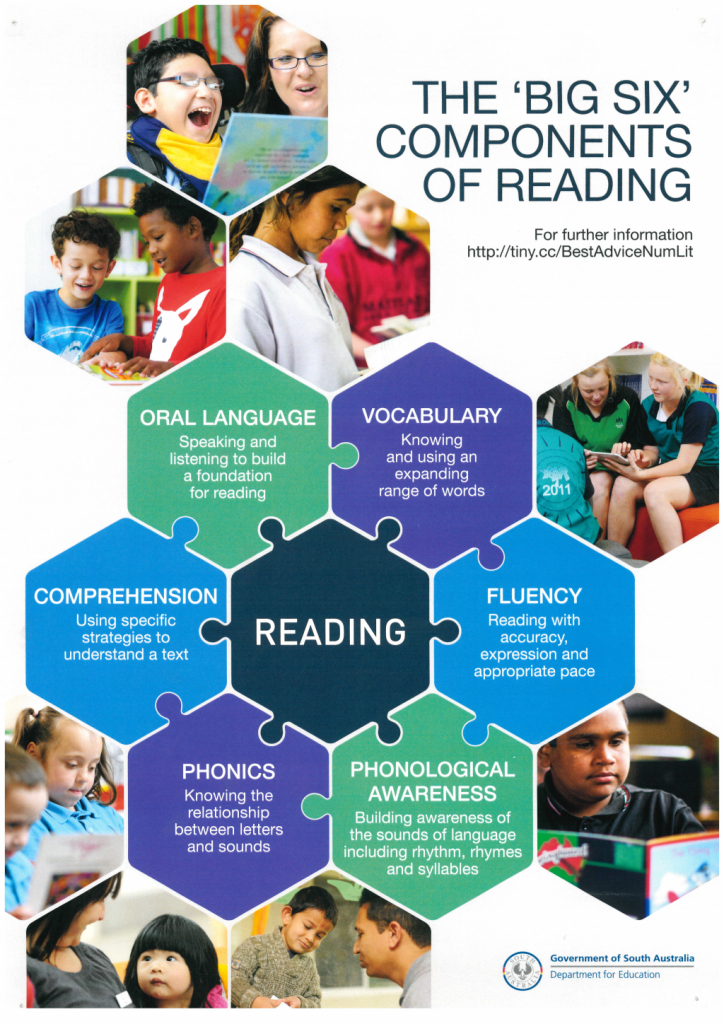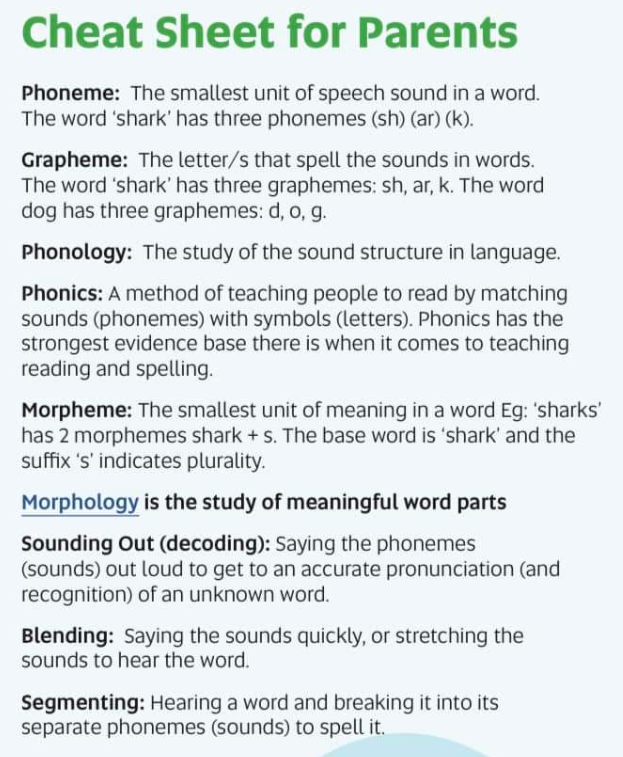Reading & Spelling
At Magill, our approach centres on the "Big 6" framework for reading and spelling proficiency. This comprehensive approach is designed to ensure that every child not only learns to read and spell but develops a profound understanding and appreciation for language.

The “Big 6” framework encompasses six crucial components that collectively form the foundation of literacy proficiency. These components are:
Phonemic Awareness: The ability to recognise and manipulate individual sounds in words.
Phonics: Understanding the relationships between letters and the sounds they represent.
Fluency: The capacity to read with accuracy, speed, and expression.
Vocabulary: The acquisition and understanding of words, their meanings, and usage.
Comprehension: Grasping the meaning of texts, interpreting information, and making connections.
Oral Language: The ability to express oneself verbally and comprehend spoken language.
To be effective readers, children need to be able to use the six components in combination. An integrated approach to explicit reading instruction is therefore essential to provide relevant learning connected to other experiences. While teachers may highlight individual components at different times, they are not a set of isolated skills and need to be integrated throughout reading opportunities across the day. So, for example, while the systematic teaching of phonics is an important component, it is not sufficient in itself for learning to read (Department for Education)
These components work synergistically to ensure a holistic literacy experience for your child. For instance, by fostering phonemic awareness and phonics skills, we empower students to decode words effectively. Fluency ensures that reading becomes a natural, smooth process, allowing attention to shift towards comprehension, where the true essence of understanding and enjoying literature lies.
R-2 Years: Sounds-Write Program
In the R-2 years, our school uses the Sounds-Write program, a "Speech to Print" approach that aligns seamlessly with the "Big 6" framework for reading and spelling proficiency. This evidence-based and Department recommended program focuses on phonemic awareness and phonics, providing explicit and systematic instruction to ensure students develop strong decoding skills. By employing a "Speech to Print" methodology, Sounds-Write establishes a consistent foundation in language development, reinforcing key elements of the "The Big 6”. This approach not only addresses the first two keys but also facilitates a smooth transition for students as they progress through their primary schooling, ensuring a cohesive and transferable learning experience.
It is based on the science of reading and provides a structured, cumulative, and code-oriented approach to teaching reading and spelling. It starts with what children learn naturally, the sounds of their own language, and teaches them to represent those sounds in writing. Sounds-Write is a complete phonics curriculum that teaches the skills, concepts, and code knowledge necessary for children to read and spell.
Students are taught four key concepts:
- Letters are symbols that represent sounds
- Sounds can be spelled using 1, 2, 3 or 4 letters (dog, street, night, dough)
- The same sound can be spelled in different ways (rain, break, stay, gate)
- The same spelling can represent different sounds (head, seat, break)
Students are taught to master three key skills:
- Segmenting - the ability to pull apart the individual sounds in words
- Blending - the ability to push sounds together to build words
- Phoneme manipulation - the ability to insert sounds into and delete sounds out of words. This skill is necessary to test out alternatives for spellings that represent more than one sound.
What do children learn in Reception?
Children in Reception begin with the Initial Code where they practise all three key skills whilst learning the one-to-one sound-spelling correspondences and securing their understanding of key concept 1. This builds up confidence and phonic knowledge enabling them to read and spell a wide range of words and sentences.
At first, children learn to read and spell simple one-syllable words with a consonant-vowel-consonant (CVC) sound structure (for example, 'sat'). By the end of Reception, they can read and write one-syllable words with up to five, or even six, sounds such as 'twist', 'grand' or 'scraps'.
Children also develop their knowledge of key concept 2 as they learn to read and spell words containing some sounds spelled with two letters (the sound /sh/ in ‘fish’ or the sound /th/ in ‘thin’, for example) as well as the three-letter spelling < tch > for the sound /ch/ in ‘catch’. Key concept 3 is introduced towards the end of Reception as the students learn about a small number of sounds that can be spelled in more than one way (for example, the sound /k/ spelled as < k > in ‘kit’, < c > in ‘cat’ and < ck > ‘pick’).
What do children learn from Year 1?
Once the Initial Code has been mastered, children continue to practise all three key skills whilst learning the Extended Code and developing key concepts 2, 3 and 4. Learning of the Extended Code is a lifelong process – we all continue to develop our understanding how to read and spell in English whenever we encounter new words. This is why the Sounds-Write approach is used right up to the end of KS2 to read and spell polysyllabic words of increasing complexity.
Children in Years 1 and 2 develop their code knowledge through explicit, systematic teaching of the Extended Code units. Polysyllabic words are introduced in Year 1.
Children in Years 3 and 4 revisit all of the Extended Code units and learn to read and spell increasingly complex polysyllabic words.
Children in Years 5 and 6 continue to consolidate and develop their knowledge, with the Sounds-Write approach used to teach the reading and spelling of vocabulary across the curriculum. There is a growing focus on etymology (the origin of words) and morphology (the structure of words).
Transition to Decodable Readers:
A significant enhancement in our literacy program is the transition from levelled texts to decodable readers. This strategic shift not only complements our adoption of Sounds-Write but also aligns seamlessly with our commitment to evidence-based practices.
Why Decodables?
Decodable readers are designed to match the phonics skills your child is learning. Encouraging decoding strategies, they focus on words that children can sound out using their knowledge of sounds and letters. Re-reading these books enhances fluency, boosts confidence, and gradually introduces more complex words, allowing students to progress at their own pace.
In 2024, we embark on an exciting journey as we fully implement the Sounds-Write program in our R-2 classes. Over the past few months, we've hosted informative parent workshops led by Genine Riley, an educational presenter, and Sounds-Write accredited trainer. These sessions not only provided valuable insights into the program but also showcased the use of decodables, highlighting their importance in reinforcing phonics skills. For those who couldn't attend, we've made the workshop video available below. It's a comprehensive resource that not only imparts information but also demonstrates the program in action, fostering a deeper understanding for parents.
Further information on Sounds-Write can be found on their website: https://sounds-write.co.uk/
A free Sounds-Write parent course can be found here: https://www.udemy.com/help-your-child-to-read-and-write/
Further information about supporting your child to read decodables can be found here: https://sounds-write.co.uk/decodables-help/
The supporting slides for the parent information sessions can be found here: Sounds-Write Parent Information Session Magill 8.2.24.pptx
Letters were sent to parents to begin 2024 to communicate these changes. They provide further context and be found at these links:
3-6 Years: Speech Sound Pics (SSP) Approach
In the 3-6 years, our commitment to the "Big 6" framework continues with the Speech Sound Pics (SSP) approach, using a routine known as ‘The Speedy Six’. Adopting another "Speech to Print" approach, this routine maintains consistency in instruction and explicit teaching, emphasising a focus on the morphology of words (affixes, Latin/Greek roots), phonemic awareness, phonics, fluency, vocabulary, and comprehension. By incorporating similar routines and rules across R-6, SSP Speedy Six Routine aligns with Sounds-Write, offering a cohesive and transferable learning experience. This ensures that, despite the distinct programs, students benefit from a consistent approach to literacy instruction, fostering a seamless progression in their reading and spelling proficiency.
To ensure that parents are actively engaged in this journey, we organised a workshop led by Maria Colarusso, an experienced educator and current Year 4 teacher at our school. Maria not only demonstrated the SSP Speedy Six Routine but also discussed its integration into the overall literacy framework. For those who couldn't attend the workshop, we've recorded the parent session, and a lesson where Maria runs through the SSP routine in her classroom. This filmed session provides a firsthand look at the program in action, giving parents valuable insights into their child's learning experience. You can find both videos below for your reference.
